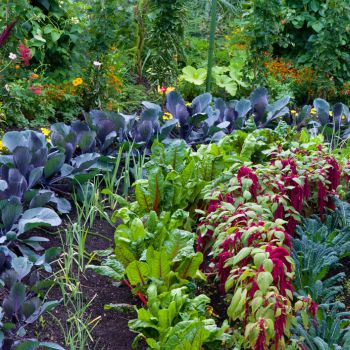As July arrives and winter takes hold, it's important not to be deterred by the cooler weather. While your garden may be at its quietest just about now, there's still plenty to be getting on with even on the coolest days.
July is a great time to tackle all those odd jobs you didn't get around to in the warmer months, such as tidying your beds, cleaning out your greenhouse or cold frame, sterilising your container collection, and spreading mulch or compost to improve your soil.
July is also an ideal time to take stock of your gardening successes and failures over the last twelve months, and to start planning for the growing season to come. Spring will be here before we know it, but in the meantime, here's what you can be doing to keep your garden ticking over...
Seeds to Sow in July
Activity in the garden doesn't need to pause completely in July, and there are plenty of seeds you can sow even in mid-winter. Unless you're in a very cold climate there's still time to sow some fast-growing lettuce or radish in an empty spot, perfect for squeezing in a last harvest before spring sowing comes around again to fill up your beds. Other seeds that can be sown in July can be found at the links below:
▩ Cold Climate: Tasmania, Melbourne, Mt Gambier, Canberra, etc.
▩ Moderate Climate: Sydney, Perth, Adelaide, etc.
▩ Warm Climate: Brisbane, Bundaberg, Carnarvon, etc.
▩ Tropical Climate: Broome, Darwin, Cairns, Townsville, etc.
▩ Not sure which climate? Click here.
Garden Tips for July
Grow Sprouts from Seed
If you prefer to stay indoors in July you can still put fresh produce on the table by growing sprouts from seed indoors. It's quick and easy, and delivers a burst of fresh flavour to your plate to liven up winter mealtimes. Our article here outlines the basic method, and we have some suggestions here for the best types of seeds for sprouting.
Winter Weather
Keep an eye on the weather forecast and protect any vulnerable plants from frost using fleece, a cloche, or a thick layer of mulch. If storms are on their way, make sure all your trellises and other supporting structures are well anchored to withstand the winds.
Winter Pruning
Many of your perennials will by now be fully dormant, and it's a good time to prune any which are sprawling out of shape. Good candidates for winter pruning include roses, fruit bushes and trees, and climbing plants including clematis. Cutting them back to size now will make them more productive and attractive when new growth arrives. However, avoid pruning any plants with live growth until all risk of frost has passed.
Plant Fruit Trees
In cooler areas, now's also a good time to plant bare root fruit trees while they're in their dormant state. There's no risk of transplantation shock to slow down future growth, and the root systems will be ready to bed in as soon as spring arrives, building strength before the summer heat.
Soil Improvement
With much of your soil lying bare around now, it's the ideal opportunity to work on improving its richness and texture. Dig some well-rotted manure or compost into the top layer of soil, working to mix it without digging too deep into the lower soil layers, and you'll both fortify its nutrient content and improve its drainage ability.
Sow Green Manure
If you have no organic material to dig in to your beds, consider sowing a green manure crop such as mustard or alfalfa. It'll keep weeds from establishing on a bare patch of soil, and by the time spring arrives it'll be ready to dig back under the surface to work as a natural fertiliser.
Don't Waste the Leaves
If there are still any autumn leaves lying around the corners of your garden, they're a valuable resource that shouldn't be wasted. Collect as many as you can and either feed them through a garden shredder or run a lawnmower over them. The chopped-up pieces will rot down much more quickly in a compost heap, or can even be dug directly into soil, keeping valuable nutrients inside your garden's ecosystem.
Continue with Pest Control
Slugs and snails might not be as rampant as in the warmer months, but you shouldn't let your guard down even in July. Continue laying beer traps and patrolling the pests' favourite areas so you can catch as many as possible, and their numbers will be less overwhelming once the growing season starts.
But there's one other annual job that traditionally starts around July. With the garden at a low ebb, you've likely got more time and energy to devote to planning your next year's gardening calendar. Which sowings worked well over the last year, and which ones could use a little improvement or experimentation? Explore our seed catalogue to find new varieties to try out, stock up on your reliable favourites, and make sure you're in prime sowing position for the springtime to come.
.jpg)





